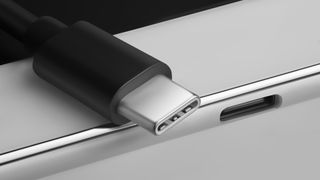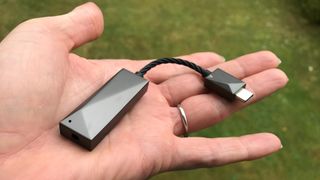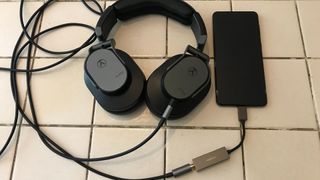Lightning be gone! Why I cannot wait for USB-C music on my iPhone
Lightning never strikes twice – except on iPhone, where its been striking out since 2012

USB-C ported iPhones are coming; that's all but certain. When, exactly, is still up for debate, but the EU says Apple must add USB-C charging ports to iPhones from 2024, and even though the UK won't actively follow the EU in enforcing this demand, it won't matter.
The EU has mandated one USB-C charger to rule them all from Apple, and Tim Cook's behemoth has been given an official two-and-a-half year deadline in which to achieve it.
Add to this certain controversial reports claiming that the iPhone 14, due to launch in September, will be the last iPhone to sport Apple's proprietary Lightning connector and it seems Apple's 2023 iPhone 15 (and even the long-rumored folding iPhone, if it materializes) could be getting USB-C – even less of a wait!
Lightning first struck in the 2012 iPhone 5 and I, for one, will not be mourning its departure. Yes, the USB-C ports are marginally wider and thicker than Lightning connections (8.4mm x 2.6mm compared with 6.7mm x 1.5mm) but it's hardly noticeable in the weights or measurements of Android phones now, is it?
Why is Apple's enforced ditching of Lightning for USB-C something you should be excited about? Several reasons, including potentially snappier charging (which will only improve with the arrival of USB-C 2.1) and improved data transmission speeds, because USB-C provides a higher power delivery rate than Lightning and delivers a speedier charge under the same voltage.
If that's all you need to know about data transfer, move to the audio paragraphs below, friend! But if you want to get to the nitty-gritty of USB-C's power-handling, strap in: Lightning supports a maximum current of 2.4A, but USB-C carries 3A with support for up to 5A, because Lightning devices transfer data at USB 2.0 speeds, which is 480Mbps, while USB-C can currently transfer data at USB 3.0 (using protocol USB 3.1 Gen 1) speeds of 5Gbps. All of which basically means less time waiting and more time enjoying. Plus, it's a more universal, brand agnostic, durable charger.
But as a music-lover, I don't want to hone in on any of those things. I want to tell you how good your USB-C iPhone is going to sound in a few short years.
Get daily insight, inspiration and deals in your inbox
Get the hottest deals available in your inbox plus news, reviews, opinion, analysis and more from the TechRadar team.
A USB-C connector will finally solve iPhone's hi-res audio accessibility issues

USB-C chargers basically mean much easier access to 24-bit hi-res audio.
But let's step back a sec. High-resolution audio is specified as any file that has been mastered above CD quality bit-rate and sampling frequency, at 16-bit/44.1kHz. Common hi-res combos here are 24-bit/96 kHz, aka the maximum resolution of Apple Music's Lossless tier, and 24-bit/192kHz – where Apple Music's Hi-Res Lossless offering maxes out.
The thing is, to have at these Hi-Res Lossless files (which, let's not forget, Apple gave to its Apple Music subscribers at no extra cost just over a year ago) on your iPhone, you currently need an elaborate wired system of components commencing with the Apple Lightning to USB camera adapter (which is limited to 24-bit/48kHz) then a third-party portable DAC to get you up to resolution, then a set of good wired headphones. Not exactly a svelte setup.
Why the DAC outsourcing? The onboard digital-to-analogue converter nestling in even Apple's most recent iPhone 13 lineup cannot support those top-tier hi-res files – so you need another, better, external one to do the heavy lifting.
Now, USB-C: although USB-C wired headphones themselves can still be a little bit hit and miss in terms of audio quality, since they can either be passive (meaning you're still beholden to the DAC in your phone for quality) or active, meaning the conversion process happens in the headphones themselves, USB-C DACs are where things get revelatory – but let's not get ahead of ourselves.
The main perk of active USB-C headphones is to prolong a digital signal state and bypass your iPhone's internal components – all that distortion from other smartphone signals and so on. But it's not a cut-and-dried, cure all solution, since the source device (read: smartphone) needs to support Audio Accessory mode – and some don't, currently. Additionally, it’s not always apparent which headphone models are active and which are passive, resulting in a super sleuth detective mission to determine whether or not the whole thing will work out.

But have a quick look at the Astell & Kern AK USB-C Dual DAC above. Suddenly, 3.5mm headphones with smartphones are back on the menu! (Although, if you still really want a 2022 smartphone with a 3.5mm connection, look to the Sony Xperia 1 IV, which lists "Hi-Res Audio" wired and wireless support from the box, although the extent of that support isn't specified).
Back to this DAC though. As one of the biggest names around where portable music players are concerned, Astell & Kern has already demonstrated supreme wizardry with onboard DACs. And for this, its first stand-alone off-board DAC, the company has knocked it clean out the park as far as I'm concerned.
This USB-C Dual DAC is essentially two little blocks (a USB-C plug and a DAC) joined by a flexible, braided cable. Sat next to any other portable DAC, it’s tiny, and it weighs around 25g. But A&K has still found room for two DAC chipsets capable of handling audio files of up to 32-bit/385kHz resolution, as well as headphone amplification. Read that again: 32-bit… 385kHz, aka serious hi-res audio, without the extra adapters, dongles and add-ons.
I currently use this setup, alongside a trusted set of Austrian Audio over-ears and a Samsung Galaxy S21. Yes, it's still a two-piece system (or three if you count the phone), but it beats the three-pronged attack I'd have to use to get anything even close to it from an iPhone. And with it, my music is both amplified and opened out, clearer and more defined, more detailed and with greater space around each note or musical passage.
This Astell & Kern DAC plugged into an iPhone for simple hi-res audio may be a few years away yet, but when it comes, I cannot wait to hear it.

Becky is a senior staff writer at TechRadar (which she has been assured refers to expertise rather than age) focusing on all things audio. Before joining the team, she spent three years at What Hi-Fi? testing and reviewing everything from wallet-friendly wireless earbuds to huge high-end sound systems. Prior to gaining her MA in Journalism in 2018, Becky freelanced as an arts critic alongside a 22-year career as a professional dancer and aerialist – any love of dance starts with a love of music. Becky has previously contributed to Stuff, FourFourTwo and The Stage. When not writing, she can still be found throwing shapes in a dance studio, these days with varying degrees of success.
